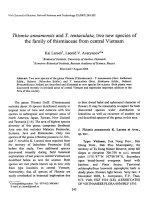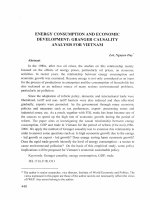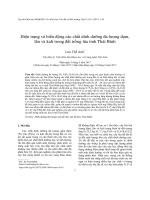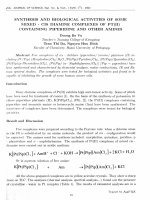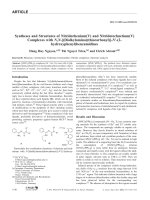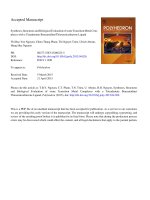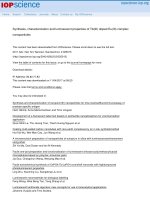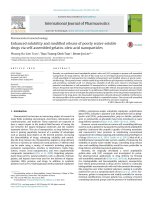DSpace at VNU: Syntheses, structures and biological evaluation of some transition metal complexes with a tetradentate benzamidine thiosemicarbazone ligand
Bạn đang xem bản rút gọn của tài liệu. Xem và tải ngay bản đầy đủ của tài liệu tại đây (891.37 KB, 22 trang )
Accepted Manuscript
Syntheses, Structures and Biological Evaluation of some Transition Metal Complexes with a Tetradentate Benzamidine/Thiosemicarbazone Ligand
Thi Bao Yen Nguyen, Chien Thang Pham, Thi Nguyet Trieu, Ulrich Abram,
Hung Huy Nguyen
PII:
DOI:
Reference:
S0277-5387(15)00223-5
/>POLY 11290
To appear in:
Polyhedron
Received Date:
Accepted Date:
5 March 2015
21 April 2015
Please cite this article as: T.B.Y. Nguyen, C.T. Pham, T.N. Trieu, U. Abram, H.H. Nguyen, Syntheses, Structures
and Biological Evaluation of some Transition Metal Complexes with a Tetradentate Benzamidine/
Thiosemicarbazone Ligand, Polyhedron (2015), doi: />
This is a PDF file of an unedited manuscript that has been accepted for publication. As a service to our customers
we are providing this early version of the manuscript. The manuscript will undergo copyediting, typesetting, and
review of the resulting proof before it is published in its final form. Please note that during the production process
errors may be discovered which could affect the content, and all legal disclaimers that apply to the journal pertain.
1
2
3
4
5
6
7
8
9
10
11
12
13
14
15
16
17
18
19
20
21
22
23
24
25
26
27
28
29
30
31
32
33
34
35
36
37
38
39
40
41
42
43
44
45
46
47
48
49
50
51
52
53
54
55
56
57
58
59
60
61
62
63
64
65
Syntheses, Structures and Biological Evaluation of some Transition Metal Complexes
with a Tetradentate Benzamidine/Thiosemicarbazone Ligand
Thi Bao Yen Nguyen,a) Chien Thang Pham,a,b) Thi Nguyet Trieu,a) Ulrich Abram,b)* Hung
Huy Nguyena)*
a)
Department of Chemistry, Hanoi University of Science, 19 Le Thanh Tong, Hanoi,
Vietnam
b)
Freie Universität Berlin, Institute of Chemistry and Biochemistry, Fabeckstr. 34-36, D-
14195 Berlin, Germany
Abstract. The potentially tetradentate benzamidine/thiosemicarbazone ligand, Et2N-(C=S)NH-C(Ph)=N-(o-C4H6)-C(Me)=N-NH-(C=S)-NH-Me
(H2L)
readily
reacts
with
Ni(CH3COO)2, [PdCl2(CH3CN)2], [PtCl2(PPh3)2] and (NBu4)[ReOCl4] under formation of
complexes of the compositions [M(L)] (M= Ni (1), Pd (2), Pt (3)) and [ReO(L)(OMe)] (4).
In all complexes, H2L is doubly deprotonated and bonded to the central meal ion via its
N2S2 donor set. Complexes 1, 2 and 3 have distorted square-planar coordination spheres,
while the rhenium compound 4 is an octahedral trans oxido/methoxido complex. The H2L
proligand shows a medium cytotoxicity with an IC50 value of 21.1 M. While the rhenium
complex 4 exhibits a stronger antiproliferative effect (IC50 =
5.52 M), the nickel,
palladium and platinum complexes are almost inactive.
Keywords: Transition Metals, Benzamidines, Thiosemicarbazones, X-ray structure,
Cytotoxicity
Corresponding Authors:
(Ulrich Abram)
(Hung Huy Nguyen)
1
1
2
3
4
5
6
7
8
9
10
11
12
13
14
15
16
17
18
19
20
21
22
23
24
25
26
27
28
29
30
31
32
33
34
35
36
37
38
39
40
41
42
43
44
45
46
47
48
49
50
51
52
53
54
55
56
57
58
59
60
61
62
63
64
65
1. Introduction
Thiosemicarbazones, which form stable complexes with many main group and transition
metals[1,2], constantly attract the interest of chemists and pharmacists due to their
remarkable biological and pharmacological properties such as antibacterial, antiviral,
antineoplastic, or antimalarial activity[3-5]. Modifications of the thiosemicarbazone
framework, in order to find new compounds with higher activity and/or to tune their
biological activity, have been extensively studied, and relationships between the biological
activity and chelate formation are evident in a number of cases[6-8].
Recently we reported the synthesis and structural characterization of a series of tridentate
benzamidine/thiosemicarbazide ligands (H2L’), which were prepared by reactions of N[N’,N’-dialkylamino(thiocarbonyl)]benzimidoyl
chlorides
(Bzm-Cl)
and
thiosemi-
carbazides [9,10]. They form stable complexes with various transition metals [9-12].
Additionally, the organic ligands as well as their oxorhenium(V) and gold(III) complexes
show a promising cytotoxicity on breast cancer cell lines [10-12]. The reaction of 2aminoacetophenone-N-(4-methylthiosemicarbazone) with Bzm-Cl results in the formation
of a tetradentate hybrid thiosemicarbazone/benzamidine ligand, H2L [13]. This ligand has
hitherto only been used for reactions with nitridotechnetium and –rhenium complexes,
which resulted in stable, neutral TcVN and ReVN complexes 13.
With respect to the stability of these products, H2L should also be suitable for the
coordination of other metal ions and the obtained products may possibly show interesting
biological properties. Here, we report about reactions of H2L with Ni(CH3COO)2,
PdCl2(CH3CN)2, PtCl2(PPh3)2 and (NBu4)ReOCl4, the structures of the obtained
products as well as their cytotoxicity against human MCF-7 breast cancer cells.
2
1
2
3
4
5
6
7
8
9
10
11
12
13
14
15
16
17
18
19
20
21
22
23
24
25
26
27
28
29
30
31
32
33
34
35
36
37
38
39
40
41
42
43
44
45
46
47
48
49
50
51
52
53
54
55
56
57
58
59
60
61
62
63
64
65
2. Results and Discussion
2.1. Syntheses and structures of the nickel, palladium and platinum complexes
H2L readily reacts with Ni(CH3COO)2, [PdCl2(CH3CN)2] or [PtCl2(PPh3)2] under formation
of complexes of the composition [M(L)] (Scheme 1). Depending on the solubility of the
starting materials, the reactions were carried out in MeOH for Ni(CH3COO)2 or in a
MeOH/CH2Cl2 mixture (v/v: 1/1) for [PdCl2(CH3CN)2] and [PtCl2(PPh3)2]. While the first
reaction proceeds very quickly, the two latter reactions require more time. The addition of a
supporting base such as Et3N accelerates the formation of the complexes and allows the
syntheses to be carried out at ambient temperature with good yields. The products are only
sparingly soluble in alcohols, but well soluble in CH2Cl2 or CHCl3 and can be recrystallized
from CH2Cl2/MeOH mixtures.
Ni(CH 3COO) 2
MeOH, Et 3N
N
- 2 Et 3NHCH 3COO
H 2L
+
[Pd(MeCN) 2Cl 2]
CH 2Cl 2 / MeOH, Et 3N
N
CH 2Cl 2 / MeOH, Et 3N
- 2 Et 3NHCl, - 2 PPh 3
S
M
- 2 Et 3NHCl, - 2 MeCN
[Pt(PPh 3) 2Cl2]
N
N
S
N
HN
1: M = Ni, 3: M = Pd; 3: M = Pt
Scheme 1.
The IR spectra of all three compounds show a moderate absorption at about 3400 cm-1,
which is assigned to the N-H stretch of the MeNH-CS group. The absorption band of
theC=N vibration is observed as a very intense band around 1550 cm-1. This corresponds to a
strong bathochromic shift of the corresponding band in H2L by about 170 cm-1. Such shifts are
commonly explained by a chelate formation with a large degree of π-electron delocalization
within the benzamidine chelate rings [9-12]. Expectedly, the 1H NMR spectra of the complexes
no longer show resonances at 12.62 ppm and 8.41 ppm, which are assigned to the NH protons
3
1
2
3
4
5
6
7
8
9
10
11
12
13
14
15
16
17
18
19
20
21
22
23
24
25
26
27
28
29
30
31
32
33
34
35
36
37
38
39
40
41
42
43
44
45
46
47
48
49
50
51
52
53
54
55
56
57
58
59
60
61
62
63
64
65
of the benzamidine and thiocarbazone moieties in the proligand. Additionally, a high field shift
of the signal of the NH proton of the CS-NHMe residue from 7.64 ppm in the proligand [13] to
the region around 5.0 ppm in the spectra of the complexes 1, 2 and 3 is observed, which
confirms that the organic ligand is doubly deprotonated and chelated to the central metal ions.
A hindered rotation around the C–NEt2 bond is observed and results in two magnetically nonequivalent ethyl groups. Thus, two triplet signals of the methyl groups of the –NEt2 residues are
observed in the 1H NMR spectra of the complexes. The signals of the two methylene groups
appear as four well separated multiplet resonances. This pattern has previously been
rationalized by the rigid structure of the tertiary amine group, which makes ethylene protons
magnetically nonequivalent with respect to their axial and equatorial positions [9,10].
Single crystals suitable for X-ray studies were obtained by slow evaporation of
CH2Cl2/MeOH mixtures for the nickel and palladium compounds. Figure 1 illustrates the
Figure 1
about here
molecular structure of 1 as a representative for this class of compounds. The structure of the
analogous palladium compound 2 is virtually identical and, thus, no extra Figure is shown.
Selected bond lengths and angles of 1 and 2 are compared in Table 1. The atomic labeling
scheme of the palladium complex has been adopted from that of the nickel complex. Both
metal ions are coordinated by the S2N2 donor set of the organic ligand in a distorted squareplanar coordination environment. The molecular planes defined by the metal atoms and the
four donor atoms S1, N5, N8 and S11 are slightly distorted with maximum deviations from
the mean least-squares planes of 0.215(1) Å for N8 (in 1) and of 0.098(1) Å for N5 (in 2).
2.1. Synthesis and structures of the oxidorhenium(V) complex
H2L reacts with (NBu4)[ReOCl4] in MeOH in the presence of the supporting base Et3N
under formation of a red crystalline solid of the composition [ReO(OMe)(L)] (4) in high
4
Table 1
about here
1
2
3
4
5
6
7
8
9
10
11
12
13
14
15
16
17
18
19
20
21
22
23
24
25
26
27
28
29
30
31
32
33
34
35
36
37
38
39
40
41
42
43
44
45
46
47
48
49
50
51
52
53
54
55
56
57
58
59
60
61
62
63
64
65
yields (Scheme 2). The reaction can be carried out at room temperature or under reflux
N
NH
(NBu 4)[ReOCl 4]
S
+
N
N
N
S
MeOH, Et 3N
- NBu 4Cl, HNEt 3Cl
N
N
S
Re
N
HN
HN
H 2L
O
OMe S
N
HN
4
Scheme 2.
without significant change in the yield.
The IR spectrum of 4 is similar to those discussed for the complexes 1 - 3 with a sharp
medium absorption band of the N-H stretch at 3387 cm-1 and a strong bathochromic shift of
the C=N band with respect to the corresponding vibration in the spectrum of H2L. The
strong absorption at 941 cm-1 is assigned to the Re=O vibration. This wavenumber is
slightly lower than those, which are normally reported for common six-coordinate
oxidorhenium(V) complexes [14], but within the typical range for octahedral trans oxido/alkoxido rhenium(V) complexes [15,16]. The 1H NMR spectrum of 4 shows the same
features as those of the nickel, palladium and platinum compounds: the absence of two N-H
resonances and a high field shift of the N-H signal of the CS-NHMe moiety to 5.26 ppm.
The chelate formation also leads to a strong downfield shift of about 1.1 ppm of the MeC=N signal. The presence of a methoxy group in 4 is clearly indicated by an additional
singlet at 3.04 ppm. The +ESI mass spectrum of 4 show no molecular ion peak, but an
intense peak at m/z = 641.11, which can be assigned to the fragment [M - OMe]+.
The X-ray diffraction data of 4 are in a good agreement with the spectroscopic results.
Figure 2
about here
Figure 2 shows the molecular structure of the complex. The environment of the rhenium
atom is best described as a distorted octahedron with an oxido and a methoxido ligand
arranged in trans positions to each other. The L2- ligand is expectedly coordinated to the
metal via its N2S2 donor set. The Re atom is located only 0.151(2) Å above the mean leastsquare plane formed by the four donor atoms of L2- towards the oxido ligand. The Re–O20
5
Table 2
about here
1
2
3
4
5
6
7
8
9
10
11
12
13
14
15
16
17
18
19
20
21
22
23
24
25
26
27
28
29
30
31
32
33
34
35
36
37
38
39
40
41
42
43
44
45
46
47
48
49
50
51
52
53
54
55
56
57
58
59
60
61
62
63
64
65
bond length of 1.917(4) Å is shorter than a typical rhenium–oxygen single bond and
reflects some double bond character. The required electron density is transferred from the
double bond of the oxido ligand. Consequently, the Re-O10 bond length of 1.707(4) Å is
slightly longer than those in five-coordinate or other octahedral oxidorhenium(V)
complexes. This is in a good agreement with the relatively low wavenumber of the Re=O
absorption in the IR spectrum of 4.
2.3. In vitro cell tests
We investigated the antiproliferative effects of the ligand H2L and its complexes on human
MCF-7 breast cancer cells in a concentration response assay. This allows the determination
of their IC50 values. The uncoordinated H2L shows an IC50 value of 21.1(9) M reflecting a
medium antiproliferative effect. The complexation of H2L with Ni2+, Pd2+ and Pt2+ ions
dramatically decreases the cytotoxicity of the compound. Thus, complex 1 only causes a
very weak reduction of the growth of human MCF-7 breast cancer cells (IC50 =
258(10)M), while complexes 2 and 3 show almost no antiproliferative effect. The low
cytotoxicity of the square-planar complexes reflects their limited dissociation inside the cell
and the stable metal chelates themselves exhibit no antiproliferative effects. This can be
understood by the rigid tetradentate N2S2 coordination of the ligand, which is expected to
form stable complexes with Ni2+, Pd2+ and Pt2+. Additionally, no labile coordination site is
available, as they are present in all metal complexes of the previously studied tridentate
thiosemicarbazone/benzamidine hybrid ligands, for which promising antiproliferative
effects have been found [10-12]. Such a potentially labile ligand is present in the rhenium
complex 4, where the methoxo ligand can readily be hydrolyzed, which enables the
resulting
complex
fragment
for
interactions
with
biological
targets.
In
fact,
compound 4 exhibits an IC50 value of 5.52(14) mM, which is markedly lower than that of
6
1
2
3
4
5
6
7
8
9
10
11
12
13
14
15
16
17
18
19
20
21
22
23
24
25
26
27
28
29
30
31
32
33
34
35
36
37
38
39
40
41
42
43
44
45
46
47
48
49
50
51
52
53
54
55
56
57
58
59
60
61
62
63
64
65
H2L. The cytotoxicity of 4 is in the magnitude of those reported for oxidorhenium(V) and
gold(III) complexes with tridentate H2L’ ligands [10,12], which also possess a labile
(chlorido) ligand in their coordination spheres, and it is almost equal to that of cisplatin
(IC50 = 7.10) determined under the same experimental conditions [17].
3. Conclusions
In the present communication, we could show that the benzamidine/thiosemicarbazone
hybrid ligand H2L forms stable complexes with Ni2+, Pd2+ and Pt2+ and ReO3+ metal
centers. The proligand H2L and its oxidorhenium(V) complex show some antiproliferative
effects on human MCF-7 breast cancer cells. Since H2L is the hitherto only representative
of this new class of potentially bioactive hybrid ligands, studies with other derivatives of
this class are recommended and are in preparation in our laboratories.
4. Experimental
4.1. Materials
All reagents used in this study were reagent grade and used without further purification.
H2L was prepared as reported previously 13.
4.2. Physical Measurements
Infrared spectra were measured from KBr pellets on a Shimadzu IRAffinity - 1S FTIR
spectrometer between 400 and 4000 cm-1. ESI mass spectra were measured with an Agilent
6210 ESI-TOF (Agilent Technologies). All MS results are given in the form: m/z,
assignment. Elemental analysis of carbon, hydrogen, nitrogen, and sulphur were determined
using a Heraeus Vario EL elemental analyzer. NMR-spectra were taken with a JEOL 400
MHz spectrometer or a BRUKER 500 MHz spectrometer.
4.3. Syntheses
7
1
2
3
4
5
6
7
8
9
10
11
12
13
14
15
16
17
18
19
20
21
22
23
24
25
26
27
28
29
30
31
32
33
34
35
36
37
38
39
40
41
42
43
44
45
46
47
48
49
50
51
52
53
54
55
56
57
58
59
60
61
62
63
64
65
4.3.1. Synthesis of Ni(L), 1
Ni(CH3COO)2 4 H2O (25 mg, 0.1 mmol) was added to a solution of H2L (44 mg, 0.1 mmol)
in 5 mL of MeOH. A deep red solution was obtained after the addition of three drops of Et3N,
and a dark red solid deposited within a few minutes. The mixture was stirred for additional 2 h
at room temperature and then the precipitate was filtered off, washed with MeOH and dried in
vacuum. Single crystals of 1 were obtained by slow evaporation of a CH2Cl2/MeOH (v/v: 1/1)
solution. Yield 84% (42 mg). Elemental analysis: Calcd. for C22H26N6S2Ni: C, 53.13; H, 5.27;
N, 16.90; S, 12.90%. Found: C, 53.01; H, 5.14; N, 16.95; S, 12.63%. IR (KBr, cm-1): 3407 (m),
3086 (w), 2923 (m), 1547 (vs), 1502 (vs), 1486 (s), 1424 (s), 1361 (s), 1230 (m), 1022 (m), 810
(w), 702 (m), 630 (m). 1H NMR (500 MHz, CDCl3, ppm): 1.30 (t, J = 7.0 Hz, 3H, CH3), 1.31
(t, J = 7.0 Hz, 3H, CH3), 2.70 (s, 3H, N=C-CH3), 2.97 (d, J = 5.0, 3H, NCH3), 3.69 (m, 1H,
NCH2), 3.74 (m, 1H, NCH2), 3.86 (m, 1H, NCH2), 4.09 (m, 1H, NCH2), 4.84 (s, br, NH), 6.41
(d, J = 8.0 Hz, 1H, C6H4), 6.78 (t, J = 7.7 Hz, 1H, C6H4), 6.86 (t, J = 7.7 Hz, 1H, C6H4), 7.12 (t,
J = 7.5 Hz, 2H, Ph), 7.20 (t, J = 7.3 Hz, 1H, Ph), 7.32 (d, J = 7.0 Hz, 2H, Ph), 7.52 (d, J = 8.0
Hz, 1H, C6H4). +ESI MS (m/z): 497.09, 100%, [M + H]+.
4.3.2. Synthesis of Pd(L), 2
[PdCl2(CH3CN)2] (26 mg, 0.1 mmol) was added to a solution of H2L (44 mg, 0.1 mmol) in
5 mL of a CH2Cl2/MeOH (v/v 1/1) mixture, and then three drops of Et3N were added. The
mixture was stirred for 3 h at room temperature to obtain a clear yellow solution. Slow
evaporation of the solvents gave light yellow crystals of 2. The product was filtered off, washed
with MeOH and dried in vacuum. Yield 65% ( 35 mg). Elemental analysis: Calcd. for
C22H26N6S2Pd: C, 48.48; H, 4.81; N, 15.42; S, 11.77%. Found: C, 48.21; H, 4.85; N, 15.35; S,
11.60%. IR (KBr, cm-1): 3434 (m), 3052 (w), 2967 (m), 1547 (vs), 1503 (vs), 1467 (s), 1420 (s),
1379 (s), 1223 (m), 1089 (m), 749 (m), 618 (m). 1H NMR (500 MHz, CDCl3, ppm): 1.33 (t, J
= 7.0 Hz, 3H, CH3), 1.36 (t, J = 7.0 Hz, 3H, CH3), 2.78 (s, 3H, N=C-CH3), 3.03 (d, J = 5.0, 3H,
8
1
2
3
4
5
6
7
8
9
10
11
12
13
14
15
16
17
18
19
20
21
22
23
24
25
26
27
28
29
30
31
32
33
34
35
36
37
38
39
40
41
42
43
44
45
46
47
48
49
50
51
52
53
54
55
56
57
58
59
60
61
62
63
64
65
NCH3), 3.65 (m, 1H, NCH2), 3.74 (m, 1H, NCH2), 4.04 (m, 1H, NCH2), 4.24 (m, 1H, NCH2),
4.95 (s, br, NH), 6.53 (d, J = 8.0 Hz, 1H, C6H4), 6.83 (t, J = 7.7 Hz, 1H, C6H4), 6.86 (t, J = 7.6
Hz, 1H, C6H4), 7.15 (t, J = 7.5 Hz, 2H, Ph), 7.21 (t, J = 7.2 Hz, 1H, Ph), 7.37 (d, J = 7.4 Hz,
2H, Ph), 7.59 (d, J = 8.0 Hz, 1H, C6H4). +ESI MS (m/z): 544.98, 100%, [M + H]+.
4.3.2. Synthesis of Pt(L), 3
The compound was prepared as described for complex 2, but starting from [PtCl2(PPh3)2]
(79 mg, 0.1 mmol) to obtain yellow crystals. Yield 62% ( 39 mg). Elemental analysis: Calcd.
for C22H26N6S2Pt: C, 41.70; H, 4.14; N, 13.26; S, 10.12%. Found: C, 41.63; H, 4.05; N, 13.32;
S, 10.10%. IR (KBr, cm-1): 3415 (m), 3058 (w), 2966 (m), 1548 (vs), 1502 (vs), 1467 (s), 1421
(s), 1375 (s), 1230 (m), 1081 (m), 747 (m), 623 (m). 1H NMR (500 MHz, CDCl3, ppm): 1.32
(t, J = 7.0 Hz, 3H, CH3), 1.36 (t, J = 7.0 Hz, 3H, CH3), 2.80 (s, 3H, N=C-CH3), 3.01 (d, J = 5.0,
3H, NCH3), 3.63 (m, 1H, NCH2), 3.72 (m, 1H, NCH2), 4.03 (m, 1H, NCH2), 4.25 (m, 1H,
NCH2), 4.96 (s, br, NH), 6.50 (d, J = 8.0 Hz, 1H, C6H4), 6.81 (t, J = 7.7 Hz, 1H, C6H4), 6.86 (t,
J = 7.7 Hz, 1H, C6H4), 7.14 (t, J = 7.5 Hz, 2H, Ph), 7.20 (t, J = 7.3 Hz, 1H, Ph), 7.35 (d, J = 7.5
Hz, 2H, Ph), 7.60 (d, J = 8.0 Hz, 1H, C6H4). +ESI MS (m/z): 634.08, 100%, [M + H]+.
4.3.4. Synthesis of ReO(OCH3)(L), 4
H2L (44 mg, 0.1 mmol) was dissolved in 3 mL of CH2Cl2 and added to a stirred solution of
(NBu4)[ReOCl4] (58 mg, 0.1 mmol) in 2 mL MeOH. After the addition of 3 drops of Et3N,
the reaction mixture was heated to 40 oC for 30 min. The solvent of the resulting clear red
solution was slowly evaporated to give red crystals of 4. Yield 60% (40 mg). Elemental
analysis: Calcd. for C23H29N6O2S2Re: C, 41.12; H, 4.35; N, 12.51; S, 9.55%. Found: C,
40.71; H, 4.09; N, 12.56; S, 9.21%. IR (KBr, cm-1): 3387 (m), 3070 (w), 2970 (m), 2924
(m), 2800 (w), 1558 (s), 1512 (s), 1425 (m), 1359 (m), 1288 (m), 1250 (m), 1227 (m), 1172 (w),
1110 (m), 942 (s), 810 (w), 771 (w). 1H NMR (400 MHz, CDCl3, ppm): 1.36 (t, J = 7.1 Hz,
3H, CH3), 1.41 (t, J = 7.2 Hz, 3H, CH3), 2.92 (s, 3H, N=C−CH3), 3.04 (s, 3H, OCH3), 3.14
9
1
2
3
4
5
6
7
8
9
10
11
12
13
14
15
16
17
18
19
20
21
22
23
24
25
26
27
28
29
30
31
32
33
34
35
36
37
38
39
40
41
42
43
44
45
46
47
48
49
50
51
52
53
54
55
56
57
58
59
60
61
62
63
64
65
(d, J = 5.0, 3H, NCH3), 3.74 (m, 2H, NCH2), 4.33 (m, 1H, NCH2), 4.53 (m, 1H, NCH2),
5.26 (s, br, NH), 6.56 (d, J = 7.9 Hz, 1H, C6H4), 6.82 (t, J = 7.9 Hz, 1H, C6H4), 6.91 (t, J =
8.0 Hz, 1H, C6H4), 7.15 (m, 3H, Ph), 7.52 (d, J = 7.8, 2H, Ph), 7.66 (d, J = 7.8, 1H, C6H4).
+ESI MS (m/z): 641.11, 100%, [M – OMe]+.
4.4. X-ray Crystallography
The intensities for the X-ray determinations were collected on a Bruker D8-QUEST (1 and
2) and a STOE IPDS 2T instrument (4) with Mo K radiation ( = 0.71073 Å). Standard
procedures were applied for data reduction and absorption correction. Structure solution
and refinement were performed with SHELXS and SHELXL 17]. Hydrogen atom
positions were calculated for idealized positions and treated with the ‘riding model’ option
of SHELXL. More details on data collections and structure calculations are contained in
Table 3.
4.5. In vitro cell tests
The cytotoxic activity of the compounds was determined using a MTT assay. Human
cancer cells of the cell line MCF-7 were obtained from the American Type Culture
Collection (Manassas, VA) ATCC. Cells were cultured in medium RPMI 1640
supplemented with 10% FBS (Fetal bovine serum) under a humidified atmosphere of 5%
CO2 at 37 °C. The testing substances were initially dissolved in DMSO, then diluted to the
desired concentration by adding cell culture medium. The samples (100 L) of the
complexes with different concentrations were added to the wells on 96-well plates. Cells
were detached with trypsin and EDTA and seeded in each well with 3 104 cells per well.
After incubation for 48 h, a MTT solution (20 L, 4 mg mL-1) of phosphate buffer saline
(8 g NaCl, 0.2 g KCl, 1.44 g Na2HPO4 and 0.24 g KH2PO4/L) was added into each well.
10
Table 3
about here
1
2
3
4
5
6
7
8
9
10
11
12
13
14
15
16
17
18
19
20
21
22
23
24
25
26
27
28
29
30
31
32
33
34
35
36
37
38
39
40
41
42
43
44
45
46
47
48
49
50
51
52
53
54
55
56
57
58
59
60
61
62
63
64
65
The cells were further incubated for 4 h and a purple formazan precipitate was formed,
which was separated by centrifugation. DMSO (100 µL) was added to each well to dissolve
the precipitate. The optical density of the solution was determined by a plate reader
(TECAN) at 540 nm. The inhibition ratio was calculated on the basis of the optical
densities obtained from three replicate tests.
Acknowledgements
We gratefully acknowledge financial support from NAFOSTED (Vietnam’s National
Foundation for Science and Technology Development) through project 104.02-2012.76.
and Ph.D grants from DAAD (Deutscher Akademischer Austauschdienst, Germany).
Appendix A. Supplementary data
CCDC-1052213, CCDC-1052214 and CCDC-1052215 contain the supplementary
crystallographic data for 1, 2 and 4, respectively. These data can be obtained free of charge
via
/>
or
from
the
Cambridge
Crystallographic Data Centre, 12 Union Road, Cambridge CB2 1EZ, UK; fax: (+44) 1223336-033; or e-mail:
11
1
2
3
4
5
6
7
8
9
10
11
12
13
14
15
16
17
18
19
20
21
22
23
24
25
26
27
28
29
30
31
32
33
34
35
36
37
38
39
40
41
42
43
44
45
46
47
48
49
50
51
52
53
54
55
56
57
58
59
60
61
62
63
64
65
References
[1]
M. J. M. Campbell, Coord. Chem. Rev. 15 (1975) 279.
[2]
J. S. Casas, M. S. García-Tasende, J. Sordo, Coord. Chem. Rev. 209 (2000) 49.
[3]
D. L. Klayman, J. B. Scovill, J. F. Bartosevich, J. Bruce, J. Med. Chem. 26 (1983)
39.
[4]
A. S. Dobek, D. L. Klayman, E. T. Dickson, J. P. Scovill, C. N. Oster, Arzneim.Forsch. 33 (1983) 1583.
[5]
C. J. Shipman, S. H. Smith, J. C. Drach, D. L. Klayman, Antiviral Res. 6 (1986) 197.
[6]
S. Miertus, P. Filipovic, Eur. J. Med. Chem. 17 (1982) 145.
[7]
L. A. Saryan, K. Mailer, C. Krishnamurti, W. Atholine, D. H. Petering, Biochem.
Pharmacol. 30 (1981) 1595.
[8]
L. P. Scovill, D. L. Klayman, C. Lambrose, G. E. Childs, J. D. Notsch, J. Med.
Chem. 27 (1984) 87.
9
H. H. Nguyen, P. I. da S. Maia, V. M. Deflon, U. Abram, Inorg. Chem. 48 (2009) 2.
[10]
H. H. Nguyen, J. J. Jegathesh, P. I. da S. Maia, V. M. Deflon, R. Gust, S.
Bergemann, U. Abram, Inorg. Chem. 48 (2009) 9356.
[11]
P. I. da S. Maia, H. H. Nguyen, A. Hagenbach, S. Bergemann, R. Gust, V. M.
Deflon, U. Abram, Dalton Trans. 42 (2013) 5111.
[12]
P. I. da S. Maia, H. H. Nguyen, D. Ponader, A. Hagenbach, S. Bergemann, R. Gust,
V. M. Deflon, U. Abram. Inorg. Chem. 51 (2012) 1604.
[13]
H. H. Nguyen, J. D. Castillo Gomez, U. Abram. Inorg. Chem. Commun. 26 (2012)
72.
14
U. Abram, Rhenium, in: J. A. McClevery, T. J. Mayer (Eds.), Comprehensive
Coordination Chemistry II, vol. 5, Elsevier, Amsterdam, The Netherlands, 2003, p.
271.
[15]
A. Paulo, A. Domingos, J. Marcalo, A. Pires de Matos, I. Santos. Inorg. Chem. 34
(1995) 2113
[16]
H. Braband, O. Blatt, U. Abram. Z. Anorg. Allg. Chem. 632 (2006) 2251.
12
1
2
3
4
5
6
7
8
9
10
11
12
13
14
15
16
17
18
19
20
21
22
23
24
25
26
27
28
29
30
31
32
33
34
35
36
37
38
39
40
41
42
43
44
45
46
47
48
49
50
51
52
53
54
55
56
57
58
59
60
61
62
63
64
65
[17]
L. Yan, X. Wang, Y. Wang, Y. Zhang, Y. Li, Z. Guo, J. Inorg. Biochem. 106 (2012)
46.
[18]
G. M. Sheldrick, SHELXS-97 and SHELXL-97 - A Programme Package for the
Solution and Refinement of Crystal Structures, 1997, University of Göttingen,
Germany.
19
K. Brandenburg, DIAMOND, vers. 3.2i, Crystal Impact GbR, Bonn, Germany.
13
1
2
3
4
5
6
7
8
9
10
11
12
13
14
15
16
17
18
19
20
21
22
23
24
25
26
27
28
29
30
31
32
33
34
35
36
37
38
39
40
41
42
43
44
45
46
47
48
49
50
51
52
53
54
55
56
57
58
59
60
61
62
63
64
65
Table 1. Selected bond lengths (Å) and angles (deg) in 1 and 2.
M–S1
M–S11
M–N5
M–N8
S1–C2
C2–N3
1
2.154(1)
2.157(1)
1.878(1)
1.909(1)
1.723(1)
1.355(2)
2
2.252(1)
2.270(1)
2.017(1)
2.033(1)
1.729(2)
1.348(2)
S1–M–N5
S1–M–N8
S1–M–S11
95.56(4)
166.46(4)
85.49(1)
94.85(4)
173.03(4)
88.64(2)
N3–C4
C4–N5
S11–C10
C10–N9
N9–N8
N8–C6
1
1.316(2)
1.357(2)
1.739(1)
1.300(2)
1.404(2)
1.313(2)
2
1.318(2)
1.348(2)
1.748(2)
1.296(2)
1.397(2)
1.308(2)
N5–M–N8
N5–M–S11
N8–M–S11
93.49(5)
167.64(4)
87.83(4)
91.70(6)
172.40(4)
85.14(4)
14
1
2
3
4
5
6
7
8
9
10
11
12
13
14
15
16
17
18
19
20
21
22
23
24
25
26
27
28
29
30
31
32
33
34
35
36
37
38
39
40
41
42
43
44
45
46
47
48
49
50
51
52
53
54
55
56
57
58
59
60
61
62
63
64
65
Table 2. Selected bond lengths (Å) and angles (deg) in 4.
Re–S1
Re–S11
Re–N5
Re–N8
Re–O10
O10–Re–S1
O10–Re–N5
O10–Re–N8
O10–Re–S11
O10–Re–O20
S1–Re–N5
S1–Re–N8
S1–Re–S11
2.358(1)
2.379(1)
2.095(4)
2.127(4)
1.707(4)
Re–O20
S1–C2
C2–N3
N3–C4
C4–N5
97.2(1)
91.2(2)
90.8(2)
96.0(1)
172.1(2)
93.7(1)
171.2(1)
93.5(4)
1.917(4)
1.753(5)
1.336(7)
1.311(7)
1.347(6)
S1–Re–O20
N5–Re–N8
N5–Re–S11
N5–Re–O20
N8–Re–S11
N8–Re–O20
S11–Re–O20
S11–C10
C10–N9
N9–N8
N8–C6
1.753(5)
1.309(7)
1.393(6)
1.311(7)
89.5(1)
89.8(2)
169.1(1)
84.2(2)
82.0(1)
82.8(2)
87.7(1)
15
1
2
3
4
5
6
7
8
9
10
11
12
13
14
15
16
17
18
19
20
21
22
23
24
25
26
27
28
29
30
31
32
33
34
35
36
37
38
39
40
41
42
43
44
45
46
47
48
49
50
51
52
53
54
55
56
57
58
59
60
61
62
63
64
65
Table 3. X-ray structure data collection and refinement parameter
Formula
Mw
Crystal system
a/ Å
b/ Å
c/ Å
α/o
β/o
γ/o
V/ Å3
Space group
Z
Dcalc./g cm-3
µ/mm-1
Tmin
Tmax
Abs. Corr.
No. of refl.
No. of indep.
No. param.
R1/wR2
GOF
1
C22H26N6S2Ni
497.32
Orthorhombic
13.0699(3)
17.3185(5)
20.1027(5)
90
90
90
4550.3(2)
Pbca
8
1.452
1.059
0.5457
0.7457
Multiscan
85358
5422
284
0.0266 / 0.0638
1.056
2
C22H26N6S2Pd
545.01
Orthorhombic
13.3416(3)
16.8770(5)
20.6174(5)
90
90
90
4642.3(2)
Pbca
8
1.560
1.001
0.6958
0.7457
Multiscan
76416
5774
284
0.0239 / 0.0539
1.081
4
C23H29N6O2S2Re
671.84
Triclinic
9.927(1)
10.623(1)
13.863(1)
79.89(1)
79.07(1)
64.31(1)
1286.3(2)
P-1
2
1.735
4.918
0.3537
0.7682
Integration
23666
6895
323
0.0377 / 0.0790
1.047
16
1
2
3
4
5
6
7
8
9
10
11
12
13
14
15
16
17
18
19
20
21
22
23
24
25
26
27
28
29
30
31
32
33
34
35
36
37
38
39
40
41
42
43
44
45
46
47
48
49
50
51
52
53
54
55
56
57
58
59
60
61
62
63
64
65
Figure Captions
Figure 1
Ellipsoid representation of the molecular structure of [Ni(L)] [19]. Thermal
ellipsoids represent 60 percent probability. Hydrogen atoms bonded on
carbon atoms have been omitted for clarity.
Figure 2
Ellipsoid representation of the molecular structure of [ReO(OMe)(L)] [19].
Thermal ellipsoids represent 50 percent probability. Hydrogen atoms bonded
on carbon atoms have been omitted for clarity.
17
1
2
3
4
5
6
7
8
9
10
11
12
13
14
15
16
17
18
19
20
21
22
23
24
25
26
27
28
29
30
31
32
33
34
35
36
37
38
39
40
41
42
43
44
45
46
47
48
49
50
51
52
53
54
55
56
57
58
59
60
61
62
63
64
65
Figure 1
Ellipsoid representation of the molecular structure of [Ni(L)] [19]. Thermal
ellipsoids represent 60 percent probability. Hydrogen atoms bonded on
carbon atoms have been omitted for clarity.
18
1
2
3
4
5
6
7
8
9
10
11
12
13
14
15
16
17
18
19
20
21
22
23
24
25
26
27
28
29
30
31
32
33
34
35
36
37
38
39
40
41
42
43
44
45
46
47
48
49
50
51
52
53
54
55
56
57
58
59
60
61
62
63
64
65
Figure 2
Ellipsoid representation of the molecular structure of [ReO(OMe)(L)] [19].
Thermal ellipsoids represent 50 percent probability. Hydrogen atoms bonded
on carbon atoms have been omitted for clarity.
19
1
2
3
4
5
6
7
8
9
10
11
12
13
14
15
16
17
18
19
20
21
22
23
24
25
26
27
28
29
30
31
32
33
34
35
36
37
38
39
40
41
42
43
44
45
46
47
48
49
50
51
52
53
54
55
56
57
58
59
60
61
62
63
64
65
Graphical Abstract
The potentially tetradentate benzamidine/thiosemicarbazone ligand H2L forms stable
transition metal complexes of the compositions M(L) (M = Ni, Pd, Pt) and
ReO(OMe)(L). H2L and the oxidorhenium(V) complex show a considerably cytotoxicity,
while the nickel, palladium and platinum complexes are almost inactive.
20
